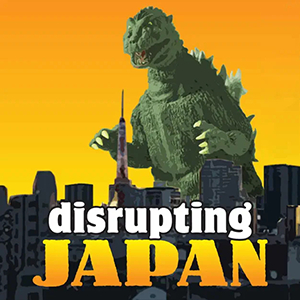This content is provided in partnership with Tokyo-based startup podcast Disrupting Japan. Please enjoy the podcast and the full transcript of this interview on Disrupting Japan's website!
Japanese HR departments are in a bit of a panic right now.
The increasing job mobility that startups have unleashed is forcing them to rethink their entire mission.
Today we sit down and Takako Ogawa, co-founder and CEO of Panalyt, a startup at the center of this transformation, and we talk about the changing career paths in Japan, when startups need to change CEOs, and the dangers of going global that people don’t seem to talk about.
It’s a great conversation, and I think you’ll enjoy it.
To listen to this podcast, please click here.

.webp)
※Top picture is Takako Ogawa, co-founder and CEO of Panalyt.
Transcript
Welcome to Disrupting Japan. Straight Talk from Japan’s most successful entrepreneurs.
I’m Tim Romero and thanks for joining me.
Japanese HR departments are in crisis right now.
Oh, life was simple back in the good old days when the big firms all recruited straight out of university and employees stayed with the company until they retired. But things are changing in Japan. People are starting to switch jobs. Companies are hiring mid-career and startups?
Well, startups are a source of employee mobility, that is forcing enterprise HR to completely rethink its entire mission.
Today we sit down and talk with someone at the center of this transformation, Takako Ogawa, co-founder and CEO of Panalyt, a startup bringing modern people analytics to Japanese HR departments.
But that was not always the case. Takako was not always the CEO and Panalyt, was not always a Japanese startup.
So, Takako and I talk about that journey. We’ll dive into how you know when a startup needs a new CEO, how to decide on your first overseas market including a few big mistakes that you should be sure to avoid. And the very important difference between having a global mindset from day one and actually being global from day one.
But, you know, Takako tells that story much better than I can. So, let’s get right to the interview.
Interview
Tim: So I’m sitting here with Takako Ogawa, the co-founder and CEO of Panalyt, who’s bringing modern people analytics to Japanese enterprise. So, thanks for sitting down with us.
Takako: Yeah, thank you.
Tim: It’s really great to have you on the show. But just for a background, what is people analytics?
Takako: So, in a nutshell, how I see people analytics is taking a scientific or data approach to HR, kind of in the same way that when you build a new product, you do AB testing, or when you’re building financial models, you test out a lot of things in numbers. And the super exciting thing is in the people space, now we can do this as well. Modern enterprises who uses a payroll system, a time and attendance system, HRIS, they have enough data to make data-driven approaches to people.

Tim: So, data-driven is good. We all like data, but what kind of decisions are these companies making? What are they improving?
Takako: I can definitely share some of the experiences at Google because back when I was there, we used data in everything. Like everything. I was astonished by how Google approached HR and that’s what got me excited in people analytics in the first place. But some of the decisions that Google made through data are things like recruiting. Google figured that after your fourth interview, you’re not getting as much returns, but you’re wasting interviewers and candidates’ time. So, we decided that there’s a rule of four, only four interviews, and you’ve got to make a decision then.
Tim: So, what data tells you that? Is it that after a candidate is passed four interviews, 99% of them will pass the next three? Or what is the data?
Takako: I guess it was more related to after you joined the company and the performance then. But that’s one example. There’s plenty others if you, if you want some of the other nuggets.
Tim: In my case, and I think for most people who are not directly involved with these startups, we see it from some of the outside. So, everyone is promising data-driven better decisions, and it’s kind of vague. So, better hiring decisions sounds great or more connected workforce sounds great, but like what are you measuring? Is it things like how much time people spend in meetings or…?
Takako: That’s a great question and I almost want to show you the product because you’ll be surprised how much things you can see through data about your organizations.
Tim: But this is an audio podcast.
Takako: Exactly. I don’t do well on audio. So, some of the easier things are like employee headcount, like how is my organization growing, have grown over the years? What’s the gender ratio? What’s the gender ratio in your management team? What’s the gender pay gap? Those are some very, very simple things. And then you get into, okay, well what’s the overlooking like, and is there a particular season your workforce is overworking or what’s the relation between overwork hours and attrition? Like, all these are KPIs that you can measure. And at Panalyt, we’ve identified close to 400 people KPIs that you could be monitoring about your company.
Tim: So, let’s talk about the overtime because I think this is something that Japan needs to work on especially. Companies are required to report over time. So, there’s a lot of nonsense in there. People will just fill out what they’re expected to. So, are you using data to, for example, see if people are really working on weekends or sending email at three in the morning?
Takako: We could do that. Well, we have this thing called organizational network analysis, but what we use is emails and chat and your action that can be tracked over your communication tools. And we could do that. But most of our customers are getting started with more simple stuff. Like a lot of our customers, when they get started with Panalyt, they don’t know their employee head count at any given time. The companies that we service are big enterprises and imagine a company that’s headquartered in Japan, but they have offices in 30 other countries. Each of these 30 different countries are using a different HRIS. So, obviously those systems don’t talk to each other. This is why you don’t understand how many people you have in your workforce.
Tim: Okay. So, currently where is this data stored? Is it just stored in a variety of different local accounting and payroll systems?
Takako: The data that we use in HRIS and payroll systems, time and attendance system, our surveys, like whatever service that they use. But we collect that do data ETL and data cleansing. And that cleaned up data that you can use for analytics is stored in our system.
Tim: Okay. I want to get back to a more deeper explanation of how this is used now and kind of the future of HR in Japan. But before that, I want to back up a bit because I think the story of Panalyt is just as interesting as Panalyt product. Panalyt was founded back in 2017 by Daniel West, and you quit Google and joined in 2019 to run Japan and eventually ended up as CEO. Let’s talk about that journey.
Takako: A good friend of mine was a good friend of Daniel, so he brought us together saying that, hey, Daniel’s building this people analytics system. It’s still in beta, but you worked in people analytics at Google, so maybe you should see the product, give him some device. And that’s how we got connected in the first place. And when I saw the mock of the product, how it moved and what kind of metrics that’s shown, it really reminded me of a system that I used as an analyst back at Google called People View. Like Google built our own in-house dashboards and like just a system where you can click a few buttons and get exactly the data you want. But I didn’t really like how the UI was set up. It’s like it was a system for analyst. But the opportunity I saw in Panalyt at that time is that this is an analytics product that looks beautiful, that this is built for line managers or executives who don’t really have the time, but they want the data, they want the information. That’s what I loved about the product.

Tim: The company was originally in Singapore.
Takako: Yes.
Tim: Actually that kind of makes sense though, because Singapore, a lot of global companies kind of have their APAC HQ in in Singapore. And was that the logic behind putting the headquarters there, or was that just where it was founded and…
Takako: It was more the latter, I think it was where Daniel was at the time.
Tim: And did that play out for you? Where did you get a lot of the international contracts in the early days?
Takako: So, in the earlier days, more in a freemium way I think it worked, but not the national brands. It’s like smaller companies. So, but big enough that they would want a people analytics product. Setting up in Singapore was maybe a good idea because a lot of the companies, their mentality is not as closed off. They’re not as afraid to be the first penguin. And you would know Japanese enterprises does not want to be the first penguin. So, I wonder maybe having startup in Singapore and having the initial few logos, even if it was premium, was a good way to get started.
Tim: Well, That’s interesting. So, you started with a freemium product in enterprise?
Takako: Mostly freemium. So, when I joined, there was almost no revenue.
Tim: So, it’s interesting. I usually caution startups against using a freemium model.
Takako: Oh, I’m the same way. When I started Japan market, I was like, no one’s getting product for free because I don’t trust words of free customers, like they’re not real customers.
Tim: It’s really interesting because I find that in B2B sales, especially enterprise sales, the cost of your product is actually a very small percentage of the cost that the customer has to pay. They’ve got to train people and go to meetings. And I find that it’s a really important filter that if the person can’t sign off on a couple thousand dollars, it’s probably best to pass.
Takako: I’d say it played out in Singapore as well, because when you look at our current customer base, all of them are Japan based mega enterprises, all of them. So, all of the initial like small accounts that we got in Singapore eventually churned.

Tim: So, who was the customer base? Was it Singaporean companies? Was it more southeast Asian companies who’d set up headquarters in Singapore for the kind of the stability? Who were they?
Takako: Even in the earlier days, and this is now thinking back, it was probably not a good thing. But in the very earlier days, the customers we were getting weren’t really Singapore companies. We had companies that were based in UK. We had companies based in well, Southeast Asia, Asia too. So Singapore, Malaysia, Indonesia were some of the locations. And obviously Japan was a big market. We had partners in Italy and Brazil so it was everywhere.
Tim: So, how did that happen? I mean, going global is a great thing, but was it just serendipity? Was it just people finding you on the web? Were you reaching out to partners? How did you end up with such a diverse customer base?
Takako: Number one is because the demand was everywhere. This is a good thing for our business. Demand was everywhere. And we were also doing a lot of things online. So, posting on LinkedIn or just online marketing. And then customers would find us and we’d be, oh, you’re a HR agency in Italy and you’re interested in being a resale partner, or, oh, you’re a FinTech company in UK and you needed a product like ours. And we never shut doors. So, everybody kept on coming. But the problem is, every startup you need to find your niche and dominate it. You need to understand your customer’s core pain and needs very, very clearly in order to grow your product well. And when you’re spread thin across regions, across different sectors, and across different employee sizes of clients, it was a mess.
Tim: I think this is a really important thing to understand because I mean, especially a lot of Japanese founders, everyone’s telling them the importance of going global, which is absolutely true. And it’s really hard to turn down business. You just don’t want to do that. So, were the needs of the customers in Italy significantly different from those in Brazil? And did you find yourself getting pulled in a lot of different directions?
Takako: Absolutely. But even worse, I’d say we weren’t even there. We did not understand the customers in Brazil or the customers in UK. That’s why eventually they all churned without telling us what the problem was.
(Continued on Disrupting Japan)
[ This content is provided in partnership with Tokyo-based startup podcast Disrupting Japan. Please enjoy the podcast and the full transcript of this interview on Disrupting Japan's website! ]
![[Podcast] Startups need to think global, but you need to beware of being global](https://storage.googleapis.com/jstories-cms.appspot.com/images/1712893043133takako-ogawa-_1_.png)
![[Interview] Longtime startup watcher predicts more 'unicorns' in Japan](https://storage.googleapis.com/jstories-cms.appspot.com/images/1691573339231%E3%82%B9%E3%82%AF%E3%83%AA%E3%83%BC%E3%83%B3%E3%82%B7%E3%83%A7%E3%83%83%E3%83%88%202023-08-09%2018.25.29_smallthumbnail.png)
![[Podcast] How one innovative startup is selling true bionic legs](https://storage.googleapis.com/jstories-cms.appspot.com/images/1688097333972main_smallthumbnail.jpg)
![[Podcast] Legal AI will shatter your perspective on legal advice](https://storage.googleapis.com/jstories-cms.appspot.com/images/1691548410335unnamed_smallthumbnail.jpeg)


![[Podcast] Japanese technology to supercharge human fertility (Part 3)](https://storage.googleapis.com/jstories-cms.appspot.com/images/1766558713084place-for-scientific-research-2025-03-07-14-08-49-utc%20(1)_bigthumbnail.jpeg)
![[Interview: Part 2] A digital approach to tackle child hunger in Japan with dignity](https://storage.googleapis.com/jstories-cms.appspot.com/images/1766130666509unnamed_bigthumbnail.jpg)
![[Podcast] Japanese technology to supercharge human fertility (Part 2)](https://storage.googleapis.com/jstories-cms.appspot.com/images/1765863548035unnamed-7_bigthumbnail.jpg)
![[Podcast] Japanese technology to supercharge human fertility (Part 1)](https://storage.googleapis.com/jstories-cms.appspot.com/images/1765440905082unnamed_bigthumbnail.jpg)
_bigthumbnail.jpeg)




![[Interview] When digital and physical worlds meet](https://storage.googleapis.com/jstories-cms.appspot.com/images/1747974430456unnamed-2_smallthumbnail.png)

![[Interview] How Japanese musician Grover turned his passion of ‘sound’ into a health-tech startup](https://storage.googleapis.com/jstories-cms.appspot.com/images/1746181078493R7__1407_smallthumbnail.jpg)


_smallthumbnail.jpeg)

![[Interview: Part 1] From nourishing souls to feeding the hungry](https://storage.googleapis.com/jstories-cms.appspot.com/images/1763695595492unnamed_smallthumbnail.jpg)

